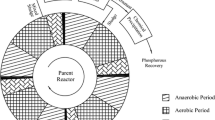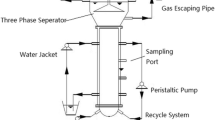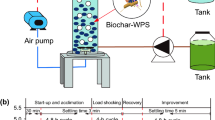Abstract
A novel technique to co-immobilize humus-reducing microorganisms and humic substances (HS), supported on γ-Al2O3 nanoparticles (NP), by a granulation process in an upflow anaerobic sludge bed (UASB) reactor is reported in the present work. Larger granules (predominantly between 1 and 1.7 mm) were produced using NP coated with HS compared to those obtained with uncoated NP (mostly between 0.25 and 0.5 mm). The HS-enriched granular biomass was then tested for its capacity to achieve the reductive decolorization of the recalcitrant azo dye, reactive red 2 (RR2), in the same UASB reactor operated with a hydraulic residence time of 12 h and with glucose as electron donor. HS-enriched granules achieved higher decolorization and COD removal efficiencies, as compared to the control reactor operated in the absence of HS, in long term operation and applying high concentrations of RR2 (40–400 mg/L). This co-immobilizing technique could be attractive for its application in UASB reactors for the reductive biotransformation of several contaminants, such as nitroaromatics, poly-halogenated compounds, metalloids, among others.







Similar content being viewed by others
References
Alvarez LH (2012) Immobilization of humic substances on metal-oxides (nano) particles and their impact on redox processes. Ph.D. Thesis, Instituto Potosino de Investigación Científica y Tecnológica, San Luis Potosí, Mexico
Alvarez LH, Cervantes FJ (2012) Assessing the impact of alumina nanoparticles in an anaerobic consortium: methanogenic and humus reducing activity. Appl Microbiol Biotechnol 95:1323–1331
Alvarez LH, Perez MA, Rangel JR, Cervantes FJ (2010) Immobilized redox mediator on metal-oxides nanoparticles and its catalytic effect in a reductive decolorization process. J Hazard Mater 184:268–272
Alvarez LH, Jimenez L, Hernandez-Montoya V, Cervantes FJ (2012) Enhanced dechlorination of carbon tetrachloride by immobilized fulvic acids on alumina particles. Water Air Soil Pollut 223:1911–1920
Amezquita-Garcia HJ, Razo-Flores E, Cervantes FJ, Rangel-Mendez JR (2013) Activated carbon fibers as redox mediators for the increased reduction of nitroaromatics. Carbon 55:276–284
Amezquita-Garcia HJ, Razo-Flores E, Cervantes FJ, Rangel-Mendez JR (2015) Anchorage of anthraquinone molecules onto activated carbon fibers to enhance the reduction of 4-nitrophenol. J Chem Technol Biotechnol. doi:10.1002/jctb.4478
Baêta BEL, Luna HJ, Sanson AL, Silva SQ, Aquino SF (2013) Degradation of a model azo dye in submerged anaerobic membrane bioreactor (SAMBR) operated with powdered activated carbon (PAC). J Environ Manag 128:462–470
Beydilli MI, Pavlostathis SG, Tincher WC (2000) Biological decolorization of the azo dyes reactive red 2 under various oxidation- reduction conditions. Water Environ Res 72:698–705
Cervantes FJ, Dos Santos AB (2011) Reduction of azo dyes by anaerobic bacteria: microbiological and biochemical aspects. Rev Environ Sci Biotechnol 10:125–137
Cervantes F, Monroy O, Gómez J (1998) Accumulation of intermediates in a denitrifying process at different copper and high nitrate concentrations. Biotechnol Lett 20:959–961
Cervantes FJ, Duong-Dac T, Roest K, Akkermans ADL, Lettinga G, Field JA (2003) Enrichment and immobilization of quinone-respiring bacteria in anaerobic granular sludge. Water Sci Technol 48:9–16
Cervantes FJ, Gonzalez-Estrella J, Marquez A, Alvarez LH, Arriaga S (2011) Immobilized humic substances on an anion exchange resin and their role on the redox biotransformation of contaminants. Bioresour Technol 102:2097–2100
Colunga A, Rangel-Mendez JR, Celis MLB, Cervantes FJ (2015) Graphene oxide as electron shuttle for increased redox conversion of contaminants under methanogenic and sulfate-reducing conditions. Bioresour Technol 175:309–314
Gong W, Liu X, Xue W, Fu W, Cheng D (2014) Reduction of nitrobenzene with sulfides catalyzed by the black carbons from crop-residue ashes. Environ Sci Pollut Res 21:6162–6169
Guerrero-Barajas C, Ordaz A, Garibay-Orijel C, García-Solares SM, Bastida-Gonzalez F, Zarate-Segura PB (2014) Enhanced sulfate reduction and trichloroethylene (TCE) biodegradation in a UASB reactor operated with a sludge developed from hydrothermal vents sediments: process and microbial ecology. Int Biodeterior Biodegrad 94:182–191
Guo J, Zhou J, Wang D, Tian C, Wang P, Salah Uddin M, Yu H (2007) Biocatalyst effects of immobilized anthraquinone on the anaerobic reduction of azo dyes by the salt-tolerant bacteria. Water Res 41:426–432
Guo J, Kang L, Lian J, Yang J, Yan B, Li Z, Liu C, Yue L (2010) The accelerating effect and mechanism of a newly functional bio-carrier modified by redox mediators for the azo dyes decolorization. Biodegradation 21:1049–1056
Lettinga G, van Velsen AFM, Hobma SW, de Zeeuw W, Klapwijk A (1980) Use of the upflow sludge blanket (USB) reactor concept for biological wastewater treatment, especially for anaerobic treatment. Biotechnol Bioeng 22:699–734
Li L, Wang J, Zhou J, Yang F, Jin C, Qu Y, Li A, Zhang L (2008) Enhancement of nitroaromatic compounds anaerobic biotransformation using a novel immobilized redox mediator prepared by electropolymerization. Bioresour Technol 99:6908–6916
Martínez CM, Celis LB, Cervantes FJ (2013a) Immobilized humic substances as redox mediator for the simultaneous removal of phenol and Reactive Red 2 in a UASB reactor. Appl Microbiol Biotechnol 97:9897–9905
Martínez CM, Alvarez LH, Celis LB, Cervantes FJ (2013b) Humus reducing microorganisms and their valuable contribution in environmental processes. Appl Microbiol Biotechnol 97:10293–10308
Oh SY, Son JG, Chiu PC (2013) Biochar-mediated reductive transformation of nitro herbicides and explosives. Environ Toxicol Chem 32:501–508
Pat-Espadas AM, Razo-Flores E, Rangel-Mendez JR, Cervantes FJ (2014) Direct and quinone-mediated palladium reduction by Geobacter sulfurreducens: mechanisms and modeling. Environ Sci Technol 48:2910–2919
Pereira RA, Pereira MFR, Alves MM, Pereira L (2014) Carbon based materials as novel redox mediators for dye wastewater biodegradation. Appl Cat B Environ 144:713–720
Ríos Del Toro EE, Celis-García MLB, Cervantes FJ, Rangel-Mendez JR (2013) Activated carbon fibers as a redox mediator for the anaerobic reduction of azo dyes. J Hazard Mater 260:967–974
Stevenson FJ (1994) Humus chemistry: genesis, composition, reactions. Wiley, New York
Su Y, Zhang Y, Wang J, Zhou J, Lu X, Lu H (2009) Enhanced bio-decolorization of azo dyes by co-immobilized quinone-reducing consortium and anthraquinone. Bioresour Technol 100:2982–2987
Takeno N (2005) Atlas of Eh-pH diagrams: intercomparison of thermodynamic databases. National Institute of Advanced Industrial Science and Technology, Research Center for Deep Geological Environments, Geological Survey of Japan Open File, Report No. 419
Tartar HV, Garretson HH (1941) The thermodynamic ionization constants of sulfurous acid at 25°. J Amer Chem Soc 63:808–816
Van der Zee FP, Bisschops IA, Lettinga G, Field JA (2003) Activated carbon as an electron acceptor and redox mediator during the anaerobic biotransformation of azo dyes. Environ Sci Technol 37(2):402–408
Wang J, Wang D, Liu G, Jin R, Lu H (2014) Enhanced nitrobenzene biotransformation by graphene-anaerobic sludge composite. J Chem Technol Biotechnol 89:750–755
Xu W, Pignatello JJ, Mitch WA (2013) Role of black carbon electrical conductivity in mediating hexahydro-1,3,5-trinitro-1,3,5-triazine (RDX) transformation on carbon surfaces by sulfides. Environ Sci Technol 47:7129–7136
Xu Q, Guo J, Niu C, Lian J, Hou Z, Guo Y, Li S (2015) The denitrification characteristics of novel functional biocarriers immobilised by non-dissolved redox mediators. Biochem Eng J 95:98–103
Yang K, Lin D, Xing B (2009) Interactions of humic acid with nanosized inorganic oxides. Langmuir 25:3571–3576
Yuan SZ, Lu H, Wang J, Zhou JT, Wang Y, Liu GF (2012) Enhanced bio-decolorization of azo dyes by quinone-functionalized ceramsites under saline conditions. Process Biochem 47(2):312–318
Zhang C, Zhang D, Li Z, Akatsuka T, Yang S, Suzuki D, Katayama A (2014a) Insoluble Fe-humic acid complex as solid-phase electron mediator for microbial reductive dechlorination. Environ Sci Technol 48(11):6318–6325
Zhang D, Zhang C, Li Z, Susuki D, Komatsu DD, Tsunogai U, Katayama A (2014b) Electrochemical stimulation of microbial reductive dechlorination of pentachlorophenol using solid-state redox mediator (humin) immobilization. Bioresour Technol 164:232–240
Zhang H, Lu H, Zhang S, Liu G, Li G, Zhou J, Wang J (2014c) A novel modification of poly(ethylene terephthalate) fiber using anthraquinone-2-sulfonate for accelerating azo dyes and nitroaromatics removal. Sep Purif Technol 132:323–329
Zhou Y, Lu H, Wang J, Li J, Zhou J, Jin R (2015) Catalytic performance of functionalized polyurethane foam on the reductive decolorization of reactive red K-2G in up-flow anaerobic reactor under saline conditions. Bioprocess Biosyst Eng 38(1):137–147
Acknowledgments
This study was financially supported by the Council of Science and Technology of Mexico (Grant SEP-CONACYT 155656) and by the Marcos Moshinsky Foundation. We thank the technical assistance of Dulce Partida, Guillermo Vidriales, Carmen Rocha and Héctor Amézquita.
Author information
Authors and Affiliations
Corresponding author
Rights and permissions
About this article
Cite this article
Cervantes, F.J., Gómez, R., Alvarez, L.H. et al. Efficient anaerobic treatment of synthetic textile wastewater in a UASB reactor with granular sludge enriched with humic acids supported on alumina nanoparticles. Biodegradation 26, 289–298 (2015). https://doi.org/10.1007/s10532-015-9734-5
Received:
Accepted:
Published:
Issue Date:
DOI: https://doi.org/10.1007/s10532-015-9734-5




